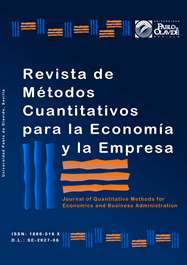Reinsurance and Distribution of Dividends as Solvency Control Tools in a Non-Life Insurance Portfolio: Analysis from the Collective Risk Theory
DOI:
https://doi.org/10.46661/revmetodoscuanteconempresa.2977Keywords:
cartera de seguros no vida, reservas, dividendos, reaseguro, probabilidad de alcanzar la barrera, distribución Erlang., non-life insurance portfolio, reserves, dividends, reinsurance, probability of reaching the barrier, Erlang distributionAbstract
The object of study of this paper is the analysis of the level of reserves in a non-life insurance portfolio. The approach to this tool as an indicator of the solvency of the portfolio poses an initial dilemma between the security necessary to be able to respond to the losses that have occurred and the problem generated financially by the fact of immobilizing reserves. We face therefore the disjunctive security-profitability. As a balancing element, the portfolio manager may consider the use of dividend distribution policies or reinsurance policies that are applied or modified at the time the reserves reach a certain level. Analyzing the problem from the classical hypotheses of the risk process, we consider in this work the probability that the reserves reach that predetermined level, at which time the manager may rethink his policies. This probability is obtained for a general case in which the inter-accident times and the individual amount of the loss are modeled with Erlang distributions. Finally, we present examples and numerical results that can help to understand the behavior of this probability.
Downloads
References
Castañer, A.; Claramunt, M.M.; Mármol, M. (2010). Deficit at ruin with threshold proportional reinsurance. Insurance Markets and Companies: Analyses and Actuarial Computations, 1(1), pp. 38 - 44 .
Castañer, A.; Claramunt, M.M.; Mármol, M. (2012). Ruin probability and time of ruin with a proportional reinsurance threshold strategy. TOP, 20(3), pp. 614 - 638 .
Claramunt, M.M., Mármol, M., Lacayo, R. (2005). On the probability of reaching a barrier in an Erlang(2) risk process. R. Statistics and Operations Research Transactions (SORT). Vol. 29, no 2.
De Finetti, B., (1957). Su un’impostazing alternative della teoria collective del rischio. In:Transactions of the XVth international congress of actuaties,Vol 2,433-443.
Dickson D.C.M. (1992) On the distribution of the surplus prior to ruin. Insurance: Mathematics and Economics 11, 191–207.
Dickson, D.C.M, Hipp, C. (1998). Ruin probabilities for Erlang(2) risk process. Insurance: Mathematics and Economics, 22, 251-262.
Gerber, H. U., Goovaerts, M. J. and Kaas, R. (1987) On the probability and severity of ruin. ASTIN Bulletin 17, 151–163.
Gerber, H.U. (1979). An introduction to mathematical risk theory. S.S. Huebner Foundation. University of Pennsylvania, Philadelphia.
Jessop. R. (2011). Stability and Hopf Bifurcation Analysis of Hopfield Neural Networks with a General Distribution of Delays. UWSpace. http://hdl.handle.net/10012/6403.
Kaas, R., Goovaerts, M., Dhaene, J., Denuit, M (2008). Modern Actuarial Risk Theory Using R. Springer-Verlag. Berlin-Heidelberg.
Panjer, H., Willmot, G.E. (1992). Insurance Risk Models. Society of Actuaries.
Downloads
Published
How to Cite
Issue
Section
License
Copyright (c) 2019 Journal of Quantitative Methods for Economics and Business Administration

This work is licensed under a Creative Commons Attribution-ShareAlike 4.0 International License.
Submission of manuscripts implies that the work described has not been published before (except in the form of an abstract or as part of thesis), that it is not under consideration for publication elsewhere and that, in case of acceptance, the authors agree to automatic transfer of the copyright to the Journal for its publication and dissemination. Authors retain the authors' right to use and share the article according to a personal or instutional use or scholarly sharing purposes; in addition, they retain patent, trademark and other intellectual property rights (including research data).
All the articles are published in the Journal under the Creative Commons license CC-BY-SA (Attribution-ShareAlike). It is allowed a commercial use of the work (always including the author attribution) and other derivative works, which must be released under the same license as the original work.
Up to Volume 21, this Journal has been licensing the articles under the Creative Commons license CC-BY-SA 3.0 ES. Starting from Volume 22, the Creative Commons license CC-BY-SA 4.0 is used.










